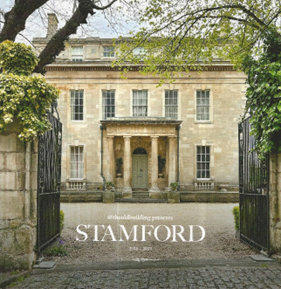Stamford 2018 – 2023 - Presented by @theoldbuilding
Self-published in 2023. Hardback. ISBN 9781399964623
Those
who
use
Instagram
may
already
follow
@theoldbuilding.
It
was
set
up
by
a
Stamford
resident
who
is
a
keen
photographer
with
an
eye
for
good
architecture
and
attractive
buildings.
Contributors
regularly
post
pictures
of
Stamford
buildings
and
scenes
online.
This
book
comprises
some
of
the
best
photographs
they
had
taken
between
2018
and
2023
with
their
iPhone
cameras.
This
proves
how
versatile
and
responsive
modern
phone
cameras can be to the architectural and landscape historian.
The
author,
who
remains
anonymous,
chose
to
disseminate
some
of
their
photographs
in
a
more
traditional
medium:
that
of
the
printed
photographic
album/book.
The
text
is
minimal
as
the
photographs
speak
for
themselves.
They
are
well
chosen,
contain
a
wealth
of
architectural
and
interesting
detail
as
well
as
being
beautiful
in
their
own
right.
The
high
production
value
of
this
186
page
hardcover
book
printed
on
glossy
paper
is
reflected
in
the
price
of
£28.
However,
it
is
well
worth
the
money.
It
is
not
a
standard
'coffee
table
book',
firstly
it
will
fit
in
a
standard
bookcase,
secondly
it
is
distinctly
browsable.
Even
the
most
jaundiced
local
resident
who
passes
through
Stamford
regularly,
perhaps
without
fully
appreciating
the
beauty
of
the
town,
will
find
something
of
interest
to
appreciate
in
this
gorgeous
collection
of
photographs.
Apart
from
a
brief
introduction
and
title
page
no
production
details
are
given
on
the
book
itself.
It
does
however
show
the
quality
of
what
can be produced with modern technology for the modern market.
Dr Hilary Crowden

Researching Rutland
Copyright © Rutland Local History and Record Society. - All rights reserved
Registered Charity No 700273


Book Review



Researching Rutland
© Rutland Local History and Record Society
Registered Charity No 700273

Book Review
William Browne’s Town: The Stamford Hall Book 1465-1492
Stamford Survey Group in association with Stamford Town Council and
Stamford Civic Trust
Stamford is fortunate to have a Hall Book, a record of the council minutes
of the town. Until now it has remained in the town’s archives only to be
seen by historians with an appointment. With this transcript Alan Rogers
has made the first part of the Hall Book accessible to all and we are given
the opportunity to step back in time and discover what life was really like
in the fifteenth century. Future volumes are planned which will continue
the story of Stamford’s town affairs.
The book gives a remarkable insight into the lives of townspeople in
medieval England covering the years from 1465, shortly after the town’s
incorporation, until 1489 just after the death of William Browne. William
Browne was a very rich and important Merchant of the Staple. He
controlled the affairs of the town during this period, serving as Alderman
on several occasions. His legacy to Stamford is All Saints’ Church and
Browne’s Hospital.
As today, rules and regulations governed the lives of townsfolk. The
minutes record laws forbidding Sunday trading and fines for leaving
horses tied up in the wrong places on market days – as the editor
comments, ‘There were parking penalties even in medieval Stamford’. We
also find that there were designated places for dunghills and times when
animals could be brought into town. From this book we learn how law
and order was enforced and the punishments meted out to wrongdoers.
Perhaps the most interesting aspect of the volume is the tremendous
number of different trades pursued in the town. The wardens strictly
controlled the craftsmen to ensure the quality of goods and there was a
diversity of rules governing the guilds and the pageant of Corpus Christi.
Alan Rogers has had close links with Stamford and readers will no doubt
be familiar with his books The Medieval Buildings of Stamford
(Nottingham 1970), The Book of Stamford (Buckingham 1983) and, with
JS Hartley, The Religious Foundations of Medieval Stamford
(Nottingham 1974). He has also been closely involved with local history in
Rutland, most recently in Uppingham, inspiring and encouraging local
historians to record aspects of the history of that town.
For this volume Professor Rogers has written an excellent introduction
including the insight he has gained about the role of William Browne in
making the transcript. He also adds useful comments throughout the
volume and there is an excellent index. It is a shame that the Editorial
Conventions are not at the front of the book and a glossary would have
been useful for those less familiar with the legal terms of the medieval
period. Do not however be deterred by the plain cover: inside it is a
fascinating record not just for people in Stamford but for anyone
interested in town life in the Middle Ages. It is a book to dip into, and read
aloud it comes to life. It certainly merits a place on the bookshelf of
anyone interested in history.
Jean Orpin







